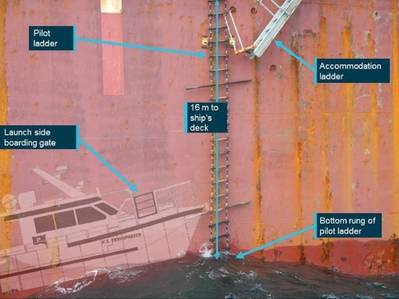ATSB: Fatal Pilot Ladder Accident Has Enduring Lessons
Managers of the two vessels involved in a fatal crew transfer accident off Brisbane, Australia, had not ensured personnel had a common and complete understanding of how the transfer would be conducted, an Australian Transport Safety Bureau (ATSB) investigation has concluded.
On 9 August 2021, crew were being transferred to and from the bulk carrier Formosabulk Clement via the launch boat PT Transporter in the Port of Brisbane anchorage, about five nautical miles off the coast.
The operation involved multiple visits from PT Transporter to transfer crew on and off the anchored bulk carrier. While the vessels were separated during a break from transfers before the accident, the bulk carrier turned about its anchor, exposing the transfer area to prevailing weather.
Language difficulties between the crews meant the bulk carrier’s main engine was not used to correct this issue, prior to the launch coming back alongside. As PT Transporter approached, a crewmember of the bulk carrier climbed down the vertical pilot ladder without the knowledge of the ship’s master, or the skipper of the launch.
A wave, larger than previously encountered, then lifted the PT Transporter higher than expected, sufficient for the smaller vessel to make contact with the crewmember, knocking them into the water. While the crewmember was quickly recovered from the water, they had sustained fatal injuries.
“This was a tragic accident, involving a seafarer who had been at sea for more than 400 days due to global border restrictions during the COVID-19 pandemic,” ATSB Chief Commissioner Angus Mitchell said.
The ATSB’s report notes the bulk carrier was en route to Newcastle and was not scheduled to call at a Queensland port but had stopped at Brisbane’s outer anchorage to conduct a crew transfer under Maritime Safety Queensland’s ‘COVID crew transfer’ protocols, an equivalent of which was not available in New South Wales.
“At the time, Queensland was considered the most viable jurisdiction in Australia for the transfer and quarantine of ship crew, and more than 9,000 seafarers from almost 1,500 ships had passed through Queensland ports between May 2020 and July 2021, while remaining COVID safe.”
Mitchell said the investigation highlights clear safety lessons for all operators conducting crew transfers like this one, as there was no common or complete understanding amongst the personnel on board either vessel in terms of how the transfer would be conducted.
“Clear, unambiguous communications within and between workgroups are essential for the safe completion of any task,” he said. “On this occasion, key personnel misinterpreted the actions and intentions of other parties.
“Problems with language, translation and interpretation are known risks in international shipping that were not adequately mitigated on this occasion. Both ship and launch crew assumed those on the other vessel understood what was happening and about to happen and were experienced in the transfer operation from each other’s perspective – but this simply was not the case.”
Since the accident, the operator of the launch has updated crew transfer arrangements and procedures, with a traffic light system for operational assessment and control. The system is designed to be less constrained by language, and amenable to being shared beforehand to assist in achieving the shared mental model of the task among all participants.
The operator of the bulk carrier has also completed investigations and held multiple safety meetings and training exercises to share details of, and lessons learned from, the accident.
Additionally, Maritime Safety Queensland amended its COVID crew change procedure for vessels at anchor, including limiting crew changes to risk-assessed conditions and daylight hours only.
“All parties are reminded of the importance of maintaining active and adaptable communications before and during the planning, co-ordination and control of a complicated task,” Mitchell said. “Where possible, all parties should share plans and information well before undertaking a task so as to allow all involved to have a common and complete understanding of the planned activity.”











